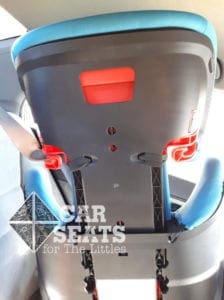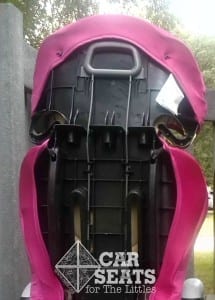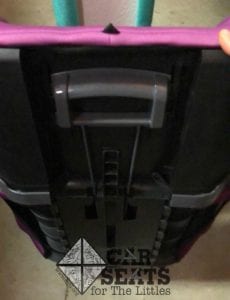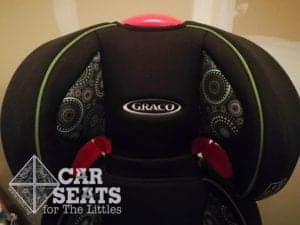It seems obvious enough to us as Child Passenger Safety technicians — a high back booster seat’s headrest grows with the child. On most booster seats, the headrest adjuster is clearly marked with a handle. As the child grows, squeeze the handle to raise the headrest and keep it in the correct place behind the child’s head. This simple adjustment ensures a proper, comfortable fit for your young passengers, but it’s one that a lot parents don’t do.
Instead, we see many a high back booster with the headrest in the lowest position. In the worst cases, this places the headrest somewhere behind the child’s back. Not only does a low headrest place the vehicle seat belt in an incorrect position, having the headrest itself behind the child presents an additional danger. Instead of being cradled by a properly fitting booster seat in the event of a crash, the child’s body could be thrown against the wrong part of the booster seat!
For a vehicle seat belt to do its job in a sudden stop or collision, it needs to stop the body’s movement using the large bones of the hips and collarbone. If that vehicle seat belt is in contact with the flesh of the abdomen rather than the bones of the pelvis, a sudden stop can allow the belt to cause severe internal injuries.
Inertia is a powerful thing: when we travel at 25 or 75 miles per hour, the force needed to stop us suddenly is immense. Our vehicle seat belts need to put that pressure on big strong bones, not delicate organs.
Different booster seats do the job of positioning the seat belt on the child’s strong bones differently, but they all need to be properly used to work. The booster seat needs to position the lap belt needs to be low on the child’s hips, contacting the thighs, and the shoulder belt across the collarbone.
 Our big kids don’t grow as astonishingly fast as our babies, but they still can and do grow overnight, so it’s important to keep an eye on how our big kids are fitting in their boosters and adjust them accordingly. Here are some tips and tricks for making those booster seats fit properly!
Our big kids don’t grow as astonishingly fast as our babies, but they still can and do grow overnight, so it’s important to keep an eye on how our big kids are fitting in their boosters and adjust them accordingly. Here are some tips and tricks for making those booster seats fit properly!
Types of Booster Seats
Boosters come in two varieties: high back and backless. Those names mean exactly what you think they do: high back boosters include a piece that sits behind the child’s back and backless boosters do not have that piece.
High Back booster seats position both the lap and the shoulder belt over the child. Some models convert to a backless booster once the child has outgrown high back mode while other high back booster seats do not convert.
Backless boosters only position the lap portion of the vehicle seat belt over the child. The shoulder belt falls into place without help from the booster seat.
High back booster seats feature a shoulder belt guide that has to be adjusted to the proper height so that the shoulder belt lies across the center of the child’s shoulder. Many children will ride in a high back booster seat from the age of 6 to 10 or 12 — every dedicated booster seat adjusts as your child grows.
Raise that Headrest!
It’s essential to adjust your child’s booster seat as they grow. To protect your child properly, a booster seat must place the vehicle seat belt:
- Across the child’s hips, touching the thighs (not halfway down their legs or on the abdomen)
- Across the center of the child’s collarbone
If the vehicle seat belt isn’t in position over these strong bones, the vehicle seat belt can’t do its job in a collision or even a quick stop.
How to Adjust
The exact method to adjust your child’s booster will be outlined in your manual. However, we’ve compiled a few tips to make sure that your child always fits properly in their booster seat.
Here’s how some of the most popular boosters adjust to get a perfect belt fit for your growing big kid.
Britax Highpoint / Midpoint / Skyline: Squeeze the handle at the back of the head rest and pull up to raise the head rest and shoulder belt guide.
Evenflo BigKid/Big Kid Amp: Squeeze the red handle at the back of the head rest and pull up to raise the head rest and shoulder belt guide.
Evenflo Spectrum: Squeeze the handle at the back of the headrest and pull up to raise the headrest and shoulder belt guide.
Graco TurboBooster: Squeeze the red handle at the very top of the headrest and pull up to raise the headrest and shoulder belt guide.
Safety 1st Store n Go Sport / Cosco Pronto: these seats are a little different from seats with squeeze adjusters. Press the plastic piece on the back of the top portion of the booster in toward the seat then slide the headrest up or down.
Simple but Effective
Raising a booster seat’s headrests is a pretty simple process that many parents don’t know needs to happen. Instead, they take their child out of a booster seat too soon, which is the last thing we’d like to see!
If your child is having trouble fitting into that high back booster, the first thing to do is to raise the booster seat’s headrest. You can make your kiddo safer and much more comfortable with just a squeeze!









